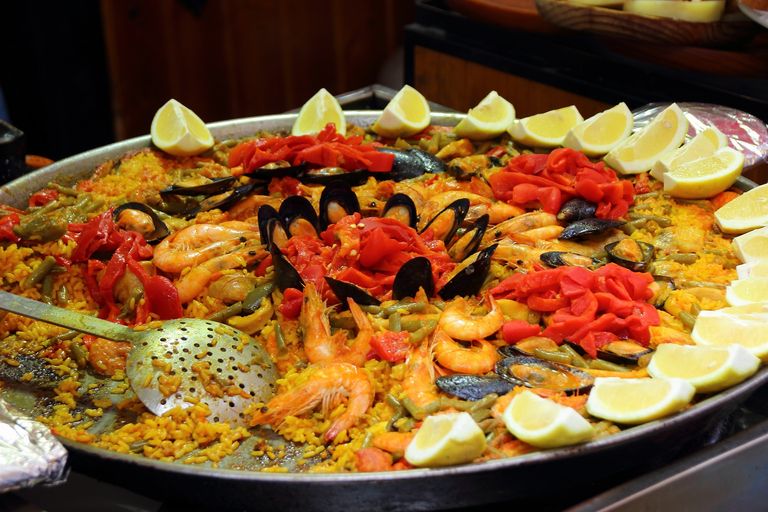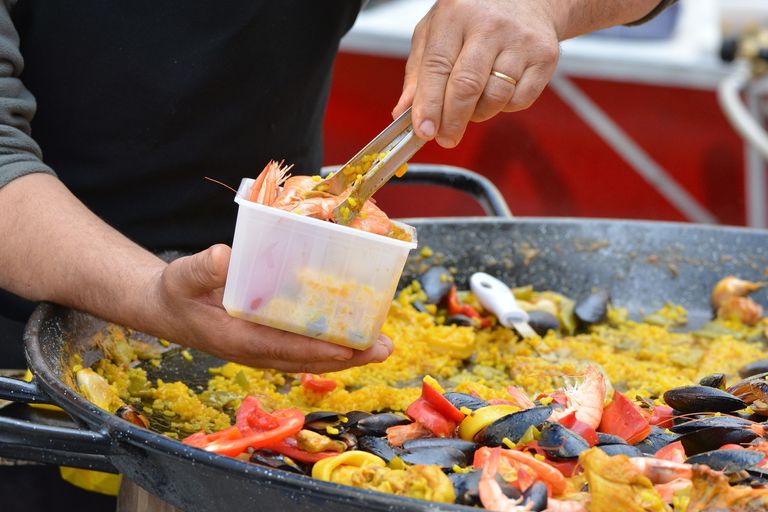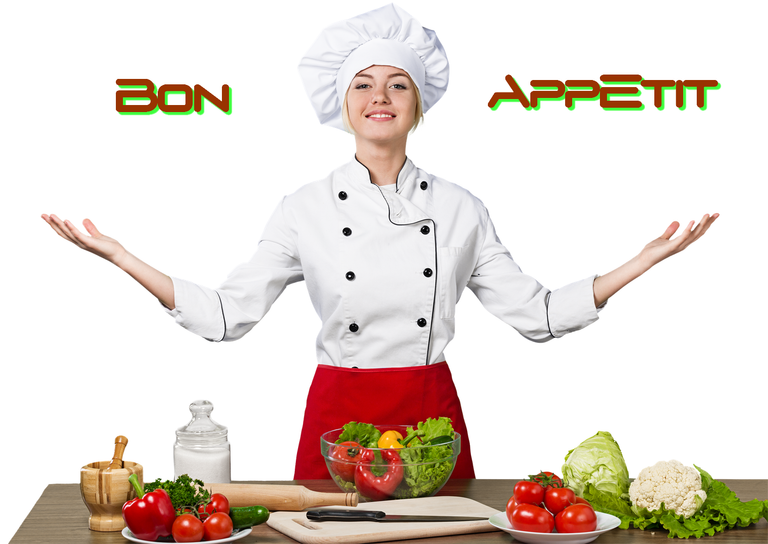
A cult of Spanish cuisine, perfect for both summer and winter: seafood paella! A dish that if you want you can also try in a carnivorous version, namely Valencian paella!
But where does this marine riot get its name? From its preparation done in a pan, or rather in "paella", the pot in which it is cooked according to tradition. Forget the classic one and look for a pan with two side handles, two handles useful for sautéing the contents in the last minutes of creaming!
This is a decidedly convivial dish, which tastes like celebration in every season... but how to do it without making mistakes? Start with the broth: try to "caramelize" all the fish you put in it and you'll see how it tastes!
Fumet is a white background made from fish and shellfish. For its preparation, fish bones and remains with a high gelatin content are used. In general, those fish and seafood that transmit good flavor to the resulting broth will be used. Fumet is a concentrated broth.

Un culto de la cocina española, perfecto tanto para verano como para invierno: ¡la paella de marisco! Un plato que si quieres también puedes probar en versión carnívora, ¡la paella valenciana!
Pero, ¿de dónde viene su nombre este motín marino? Desde su elaboración se realiza en sartén, o mejor dicho en "paella", olla en la que se cocina según la tradición. Olvídate de la clásica y busca una sartén con dos asas laterales, ¡dos asas útiles para sofreír el contenido en los últimos minutos de la crema!
Se trata de un plato decididamente agradable, que en cualquier época del año sabe a fiesta... pero ¿cómo hacerlo sin cometer errores? Empieza por el caldo: prueba a "caramelizar" todo el pescado que le pongas y verás cómo sabe!
El fumet es un fondo blanco hecho a base de pescados y mariscos. Para su elaboración se utilizan espinas y restos de pescado con alto contenido en gelatina. En general se utilizarán aquellos pescados y mariscos que transmitan buen sabor al caldo resultante. El fumet es un caldo concentrado.
Recipe for people no. 4 / Receta para personas n.4

- rice: 250g
- clams: 600g
- mussels: 600g
- shrimp: 24
- scampi: 10
- squid: 8
- tomatoes: 200 g ripe and firm or peeled
- onion: 1
- garlic:2 cloves
- peas: 200g shelled
- parsley: 1 bunch
- extra virgin olive oil: 5 tablespoons
- saffron: 1 sachet
- fish fumet
- salt
- pepper

- arroz: 250g
- almejas: 600g
- mejillones: 600g
- camarones: 24
- gambas: 10
- calamares: 8
- tomates: 200 g maduros y firmes o pelados
- cebolla: 1
- ajo: 2 dientes
- guisantes: 200 g sin cáscara
- perejil: 1 manojo
- aceite de oliva virgen extra: 5 cucharadas
- azafrán: 1 sobre
- fumet de pescado
- sal
- pimienta

** 55' + 40' cooking time. / 55' + 40' de cocción.**
- Prepare fish stock with 1 liter of water.
- Wash the mussels and clams, put them in a pan with a little chopped parsley.
- Drizzle them with 2 tablespoons of oil and open them over high heat with the pan uncovered.
- Drain them, filter the cooking liquid and set aside.
- Remove the mollusks by removing the shells and reserve some whole.
- Clean the shrimp, crayfish and squid; We wash everything carefully and cut the squid into rings.
- Chop the parsley with the garlic; cut the onion; Wash, peel and remove the seeds from the tomatoes.
- Pour 2 tablespoons of oil into a large frying pan, heat a little and add the prawns, prawns and squid and brown them quickly.
- Drain them and reserve them.
- In the same pan add the sliced onion, a little chopped garlic and parsley, the rest of the oil and let it soften, stirring frequently.
- Add the peas and brown them for a few minutes, the chopped tomatoes, a pinch of salt and cook for a few more minutes over high heat.
- Put all the already prepared ingredients back into the pan, the rest of the chopped garlic and parsley and finally the rice.
- Toast the rice for a few minutes, add the fumet (or broth), the saffron and the reserved seafood cooking liquid.
- Stir to distribute the rice evenly and cook in a covered pan for about 15 to 20 minutes.
- A few minutes before the end of cooking, add some reserved crustaceans and mollusks to decorate.
- Serve hot in the cooking container.

Elaboración:
55' + 40' de cocción.
- Preparar fumet de pescado con 1 litro de agua.
- Lavar los mejillones y las almejas, ponerlos en una sartén con un poco de perejil picado.
- Rocíalas con 2 cucharadas de aceite y ábrelas a fuego alto con la sartén destapada.
- Escurrirlas, filtrar el líquido de cocción y reservar.
- Retirar los moluscos quitándoles las conchas y reservar algunos enteros.
- Limpiar las gambas, las cigalas y los calamares; Lavamos todo con cuidado y cortamos los calamares en aros.
- Picar el perejil con el ajo; cortar la cebolla; Lavar, pelar y quitar las semillas de los tomates.
- Echar 2 cucharadas de aceite en una sartén grande, calentar un poco y añadir las gambas, las gambas y los calamares y dorarlos rápidamente.
- Escurrirlas y reservarlas.
- En la misma sartén añadir la cebolla cortada en rodajas, un poco de ajo y perejil picados, el resto del aceite y dejar que se ablande removiendo con frecuencia.
- Añade los guisantes y dóralos unos minutos, los tomates troceados, una pizca de sal y cocina unos minutos más a fuego fuerte.
- Vuelva a poner en la sartén todos los ingredientes ya preparados, el resto del ajo y el perejil picados y finalmente el arroz.
- Tostar el arroz unos minutos, añadir el fumet (o caldo), el azafrán y el líquido de cocción de los mariscos reservado.
- Revuelva para distribuir el arroz uniformemente y cocine en una sartén tapada durante aproximadamente 15 a 20 minutos.
- Unos minutos antes de finalizar la cocción añadir algunos crustáceos y moluscos reservados para decorar.
- Servir caliente en el recipiente de cocción.
Paella is a preparation based on rice, saffron and olive oil, typical of the city of Valencia, Spain.
The dish takes its name from the metal container in which it is cooked (called paellera in Valencian).
According to what has been transmitted, it is a poor dish, created to feed the servants, recycling the remains of the rich patrician tables in the large cauldrons of the kitchens of the Spanish noble palaces.
Paella is a stir-fry of meat, fish and vegetables, to which water is first added and then, after a certain cooking time, rice and saffron are added, which are cooked, stirring everything, until the liquid is completely absorbed.
Traditionally it is served at the table in the same cooking container, the paella pan, garnished with lemon slices.
The paella pan is a circular pan, and it differs from other pans not only because of the two side handles, but also because of its dimensions.
The depth is approximately five or six centimeters, while the diameter varies depending on the number of diners: on average, a 45 cm paella pan serves 4 people, a 1 meter paella pan serves 10 people. On special occasions, for example at popular festivals or charity parties, you can see gigantic paella pans in operation that exceed 2 meters in diameter.
The basic ingredients, common to all versions of paella, are rice, saffron and olive oil.
Other ingredients may vary depending on recipe, seasonal availability and personal tastes.
The traditional preparation, which has taken the name "Valencian paella", is seasoned with chicken and rabbit meat, tomato, pepper, green beans, beans and sometimes snails.
The most common variations are fish paella (with fish and vegetables), seafood paella (with seafood, crustaceans and vegetables), mixed paella (with meat and fish), cauliflower and cod paella or Lenten paella ( with cauliflower and cod, which was formerly prepared during Lent to respect the prohibition of eating meat).

La paella es una preparación a base de arroz, azafrán y aceite de oliva, típica de la ciudad de Valencia, España.
El plato toma su nombre del recipiente metálico en el que se cocina (llamado paellera en valenciano).
Según se ha transmitido, se trata de un plato pobre, creado para alimentar a los sirvientes, reciclando los restos de las ricas mesas patricias en los grandes calderos de las cocinas de los palacios nobles españoles.
La paella es un salteado de carne, pescado y verduras, al que se le añade primero agua y luego, transcurrido un tiempo de cocción determinado, arroz y azafrán, que se cuecen removiendo todo, hasta que se absorba por completo el líquido.
Tradicionalmente se sirve en la mesa en el mismo recipiente de cocción, la paellera, adornado con rodajas de limón.
La paellera es una sartén circular, y se diferencia de otras sartenes no sólo por las dos asas laterales, sino también por sus dimensiones.
La profundidad es de aproximadamente cinco o seis centímetros, mientras que el diámetro varía en función del número de comensales: de media, una paellera de 45 cm sirve para 4 personas, una de 1 metro sirve para 10 personas. En ocasiones especiales, por ejemplo en fiestas populares o fiestas benéficas, se pueden ver en funcionamiento gigantescas paelleras que superan los 2 metros de diámetro.
Los ingredientes básicos, comunes a todas las versiones de paella, son el arroz, el azafrán y el aceite de oliva.
Los demás ingredientes pueden variar según la receta, la disponibilidad estacional y los gustos personales.
La preparación tradicional, que ha tomado el nombre de "paella valenciana", se condimenta con carne de pollo y conejo, tomate, pimiento, judías verdes, judías y en ocasiones caracoles.
Las variaciones más habituales son la paella de pescado (con pescado y verduras), la paella de marisco (con marisco, crustáceos y verduras), la paella mixta (con carne y pescado), la paella de coliflor y bacalao o la paella cuaresmal (con coliflor y bacalao, que antiguamente se preparaba durante la Cuaresma para respetar la prohibición de comer carne).

Fuente imagen inicial . / Source initial image: Pixabay.
Fuente imagen final. / Source final image: Pixabay.
Estas recetas y tantas otras publicadas en #BLURT las pueden encontrar en mis blogs en italiano, inglés y español. Más de 5.000 recetas para darle fantasía y color a tu mesa y hacer una figura digna de un/a chefs con tus invitados.
These recipes and many others published in # BLURT can be found on my blogs in Italian, English and Spanish. More than 5,000 recipes to give fantasy and color to your table and make a figure worthy of a chef with your guests.
Y como siempre me despido de todos con un:
And as always I bid you all farewell with a:

Upvoted. Thank You for sending some of your rewards to @null. Read my last posts to make sure that BLURT burning is profitable for you. Before using this bot please make sure your account has at least 100 BP. Get more BLURT:
@ mariuszkarowski/how-to-get-automatic-upvote-from-my-accounts@ blurtbooster/blurt-booster-introduction-rules-and-guidelines-1699999662965@ nalexadre/blurt-nexus-creating-an-affiliate-account-1700008765859@ kryptodenno - win BLURT POWER delegationThanks @ctime